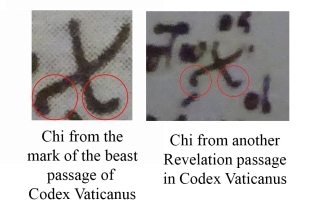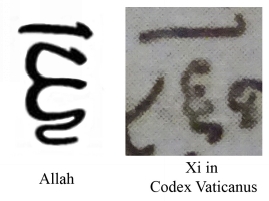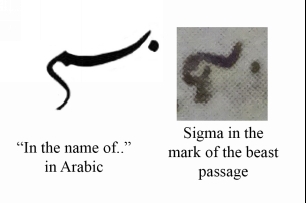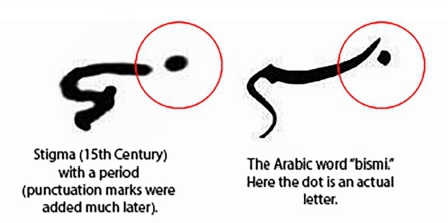Chapter 8
The Mark of the Beast
Walid Shoebat, in his book God’s War on Terror
, endorses a very unique approach to understanding the so-called “mark of the beast” in Revelation 13:18. Most Bible scholars and teachers have understood the mark of the beast in Revelation to be the number 666. Shoebat, however, proposes that John, the writer of the book of Revelation, did not intend for us to understand this mark as a number at all. Shoebat says that John was supernaturally shown the Arabic words for “in the name of Allah” and a picture of crossed swords when he was writing Revelation 13:18. John then supposedly wrote down these Arabic letters and symbols just as he saw them. Later generations of scribes, however, apparently misunderstood John’s intentions due to the Arabic symbols resembling the Greek letters Chi Xi Sigma
. These scribes wrote the Greek letters instead of the Arabic symbols when making subsequent copies, and since the Greek numbering system is based on letters, scholars mistakenly believe the mark of the beast to be the number 666
.
Contextual Problems
I begin with the argument that the context of this passage does not support his thesis. The verse in question reads as follows:
“Here is wisdom. Let him who has understanding calculate
the number
of the beast, for it is the number
of a man: His number
is 666.” (Revelation 13:18)
Notice the words “calculate” and “number” in the above verse. These words are quite blatantly telling us that we are to look for a number. Because we see phrases like “it is the number of a man,” and “his number is,” it would seem that John was well aware that he was intending the reader to understand the mark as a number.
Shoebat writes the following about this problem in his book:
“Now consider the alternate translation that the Allah Theory could produce. The Greek word Psephizo, translated above as ‘count,’ can also quite naturally mean ‘reckon’ or ‘to decide.’ Likewise, the Greek word Arithmos, translated above as ‘number’ can also mean ‘an indefinite number or multitude,’ ‘multitude,’in the case of more than one, such as a multitude of people. With this in mind, consider the following translation, as it makes very good sense:
“Here is wisdom. Let him that hath understanding reckon (or decide, discern) the multitude of the beast, for it is the multitude of a man [that is, Mohammed and or the Mahdi-Antichrist] and his multitude [are identified through the following] ‘In the Name of Allah and the two swords (or
Jihad).’”
[21]
Count/Calculate
Let’s start with the word psephizo
, which is often translated as “count” or “calculate.” Shoebat says the word can simply mean to discern or decide and doesn’t necessarily have to do with counting anything. Psephizo
is a very rare Greek word in the New Testament; in fact, the only other time it occurs in the Bible is in Luke 14:28:
“For which of you, intending to build a tower, does not sit down first and count
the cost, whether he has enough to finish it.”
Here the word is obviously used in the sense of counting. Jesus is talking about a man counting his money to see if he has enough to finish a building project. The word is never used in a general sense, as in to discern or decide. The Greek language has a much better word for that (dokimazō
), which is used quite often in the Bible, and if John had meant to simply say reckon/decide/discern in the sense Shoebat is using it, he almost certainly would have used dokimazō
.
Shoebat says that the word psephizo
(calculate/count), “can also quite naturally mean ‘reckon’ or ‘to decide.’” In other words, it can be used without reference to numbers or counting. I can only imagine Shoebat looked at some Greek lexicons like Strong’s or Thayer’s and simply saw the word “reckon” and “decide” but failed to read the full lexicon entry carefully because these lexicons clearly define the word as related to counting something. I will show you an example of one such lexicon so you can see what I
mean.
STRONGS NT 5585: ψηφίζω
ψηφίζω
; 1 aorist ἐψηφισα; (ψῆφος, which see);
to count with pebbles, to compute, calculate, reckon
: τήν δαπάνην,
Luke 14:28
; τόν ἀριθμόν, to explain by computing,
Revelation 13:18
. (Polybius, Plutarch, Palaeph., Anthol.; commonly and indeed chiefly in the middle in the Greek writings
to give one’s vote by casting a pebble into the urn; to decide by voting
.) (Compare: συγψηφίζω, καταψηφίζω, συμψηφίζω.)
[22]
The word “reckon” in the lexicon above is expected to be understood as synonymous with the other words in the definition, like “compute” and “calculate.” Reckon, in this case, is limited to reckoning as it relates to counting. Similarly, notice that in the discussion of how the word was used in other Greek writings, psephizo meant “decide” in the sense of “deciding by voting,” which is related to counting. After consulting every major Greek lexicon I have available, I have not found a single one that would allow psephizo to be used the way Shoebat uses it. If Shoebat would like people to believe his translation, I would suggest he needs to produce a Greek scholar or some very good argumentation sufficient to overturn the understanding of this Greek word in the scholarly world.
Number
The word number, which is used three times in Revelation13:18, comes from the Greek word arithmos
, which is where we get the English word arithmetic. Shoebat translates this word as “multitude.” While it is true that the word arithmos
can mean multitude, it cannot be used the way Shoebat is using it. Lexicons give two possible definitions for arithmos:
-
A fixed and definite number.
-
An indefinite number, a multitude.
The second definition is only using “multitude” in the same way that English speakers use the word “number” to describe an indefinite number (e.g., There are a number of cats over there, or The number of homicides in the city has risen alarmingly.)
One way to show that Shoebat’s translation is not possible is to first show you that the Bible already has a word for “multitude” when it is used the way that Shoebat is using it. The Bible uses the Greek word “ochlos
” to refer to a crowd of people, and it does so 175 times in the Bible, including four times in the book of Revelation (7:9, 17:15, 19:1,6). When ochlos
is used, it always describes a group of people.
“Now when the multitudes saw it, they marveled and glorified God, who had given such power to men.” (Matthew 9:8)
A good way to see the difference in these two words is to substitute “number/ arithmos
” for “multitude/ochlos
” in the sentence above:
Now when the number saw it, they marveled and glorified God, who had given such power to men. (Matthew 9:8)
In this case we would wonder the number of what?
It requires a subject because the second definition of arithmos
simply means “an indefinite number,” whereas ochlos
means a group of people, that is, only people.
I again referenced every available lexicon I have available to me and did not find a single one that would allow for Shoebat’s interpretation of this passage. When Shoebat says a Greek word “can also quite naturally mean” something else, he needs to give some significant reasons to believe him, especially considering that the reference material disagrees with him
.
Restoration Scriptures True Name Edition
Shoebat, in an attempt to justify his translation of Revelation 13:18, says the Restoration Scriptures True Name Edition
translates the passage in an almost identical way as he translates.
That leads us to a pretty interesting story. The Restoration Scriptures True Name Edition
is a translation put together by one man, a messianic author and pastor from Florida named Moshe Koniuchowsky. Koniuchowsky has many sermons that preach, almost verbatim, the theories of Walid Shoebat, including this theory about the mark of the beast. I started to expect plagiarism on the part of Shoebat when reading over Koniuchowsky’s material since it was written long before Shoebat published his books. Then I discovered the Simon Altaf connection.
Simon Altaf was a member of Koniuchowsky’s ministry team at one time and heavily influenced Koniuchowsky’s end times teachings. Walid Shoebat was a good friend of Altaf in the early days of his ministry; in fact, they wrote a book together called
This is Our Eden, This is Our End,
which is now out of print. Two years before Shoebat’s book
God’s War on Terror
came out, Altaf wrote a book called
Islam, Peace or Beast
about the Islamic Antichrist doctrine, which included the exact material on virtually every topic Shoebat covers, including the mark of the beast material that later appeared in Shoebat’s book. Altaf accused Shoebat of plagiarizing his work in an article on his website and the two are no longer friends.
[23]
Altaf’s book was published originally by Your Arms to Israel, Moshe Koniuchowsky’s ministry. Shoebat has since accused both Altaf and Koniuchowsky of being “cult leaders” who practice polygamy and bad doctrine.
[24]
It should be noted that both Altaf and Koniuchowsky do not
deny that they practice “plural marriages” and seem quite proud of that fact.
So to sum up this point, Walid Shoebat, in an attempt to justify his translation of Revelation 13:18, points us to a self-published Bible which he admits was written by a “cult leader” whom he personally knows. In addition, Shoebat clearly influenced the translation of Revelation 13:18 in Koniuchowsky’s Bible, either directly or if you believe Simon Altaf, Altaf influenced Koniuchowsky with the exact same arguments that Shoebat would later steal from Altaf. Either way, this is an absolute mess, and Shoebat does not gain an ounce of credibility for his decidedly awful translation of Revelation 13:18 by citing Koniuchowsky’s Restoration Scriptures True Name Edition.
The Greek Text
When making his case on the mark of the beast, Shoebat puts particular emphasis on the facsimile of Codex Vaticanus
that is in the library of
Bob Jones University. Shoebat claims that when he visited the library, he was surprised to find that he could read the 666 section of Revelation 13:18 because “it was in Arabic.”
The following is a picture of the two relevant images that are typically shown to demonstrate this theory. The top image is of the Arabic words “in the name of Allah,” followed by a picture of crossed swords (Arabic is written from right to left). The bottom image is from the copy of Codex Vaticanus
at Bob Jones University.
There are misrepresentations in virtually every aspect of these images, but the best place to start would be with regard to the history of this copy of Codex Vaticanus
and its lack of relevance to Shoebat’s thesis.
Throughout Shoebat’s book he continually tells his readers that the codex he saw at Bob Jones University is dated to 350 AD. This is significant because Shoebat is trying to say that the earliest copies of Revelation 13:18 looked like the image he is presenting, so convincing his readers that the image he shows them is a very early copy is paramount to his theory.
The problem is that while much of the copy of Codex Vaticanus
is dated to around 350 AD, the book of Revelation was not included in the original and was added by a scribe in the fifteenth century. The styles of writing between the early portions of the codex and the book of Revelation are vastly different. The style of the Greek text in the picture above is called “miniscule,” and it wasn’t even invented until around the ninth century.
All of the early Greek writings of the New Testament were written in a style known as Uncial, which looks nothing like Arabic.
In the image above, from the p47 fragment of Revelation which is dated to around 250 AD, you will notice that the Chi-Xi-Sigma
(666) looks very different from the way it is presented by Shoebat. The same is true with every single early copy of the book of Revelation, such as p115 (shown below) in which you can see that the sigma look very simple, like the English letter C.

In the p115 fragment (dated to around 300 AD), the number in p115 is actually 616, a variant reading of the text, which was recognized as wrong by church fathers such as Irenaus as early as 180 BC. In his book
Against Heresies, Irenaus
explains that there were some copies of Revelation that read 616, but the majority of the texts read 666 which he explained was even the opinion of those who were taught by the Apostle John “face to face.” The 666 vs 616 argument is irrelevant to our discussion at the moment. The important thing is that all early Greek writings were written in a completely different way than in the picture Shoebat shows. Remember, this is a picture which he dishonestly says was written in 350 AD, when in fact it was written over 1000 years later in a type of Greek writing that would have been completely foreign to John or any other Greek writer at the time.
Chi
As I said earlier, there are misrepresentations in every aspect of Shoebat’s images, so I will need to take it section by section in order to debunk it. I will start with the Greek letter Chi
which Shoebat says is really a picture of crossed swords.

It should first be noted that there is no actual correlation with Chi, which looks like an X, to any Arabic letter or word. When Shoebat says he was surprised he could read this section of Revelation 13:18, he couldn’t have been referring to the letter Chi
, since there is no Arabic letter equivalent to it. Instead Shoebat claims that John was shown a picture of crossed swords, which Shoebat says, “is used universally throughout the Muslim world to signify Islam.” So the first thing we must accept if we are to believe Shoebat’s theory is that God showed John a mixture of Arabic words, as well as a picture. It seems more likely that Shoebat, when finding no way to incorporate the letter Chi
into Arabic, had to resort to
claiming it was a picture instead of an Arabic word.
It is obvious that Shoebat would need to really emphasize the “universality” of the crossed swords relationship to Islam in order to make this theory coherent, but the crossed swords symbol is far from a universal symbol of Islam. In fact, most Jihadist flags, banners, and badges don’t contain any swords at all; some have only one sword, if any. There are a few that have two crossed swords, but only an extremely small minority of those contain the words “in the name of Allah.” The most common Arabic phrase on Islamic insignia is the “Shahada
” which says, “There is no god but God, Muhammad is the messenger of God”
and looks nothing like the Greek symbols for Chi-Xi-Sigma.

One of the many reasons Shoebat sticks to the version of Revelation 13:18 produced by this fifteenth century scribe is the way the scribe wrote the letter Chi
which is different from other scribes. It should be noted that with Greek miniscule texts in the fifteenth century, it was common for scribes to have their own unique style. This particular scribe wrote the letter Chi
with the flourishes on the bottom two legs of the X, which made it possible for Shoebat to claim they were sword handles.
There are two problems with this. The first is that this is how the scribe wrote the letter Chi
in all the other instances of the letter in the book (see
picture above). There is nothing unique about the scribe’s letter Chi
in Revelation 13:18 from any other instance of the letter Chi
. He didn’t add “sword handles” just to this verse, but apparently he added sword handles every time he wrote the letter. The second problem is that this scribe’s particular style when writing the letter Chi
(putting the flourishes on the bottom two legs) is different than other scribes of the era (see picture below), and indeed is not consistent with how the letter was written at any time, including all the earliest copies of the book of Revelation.

If flourishes were to be added to Chi
, even in the much later miniscule texts, they were almost always on the same line. Shoebat’s theory would not work with these images because that would mean one of the “swords” in the picture consists of just two handles, while the other is just two blades. We will keep running into reasons why Shoebat must stick to this particular fifteenth century scribe’s version of Revelation.
Xi
Shoebat says that the Greek letter Xi
in Revelation 13:18 corresponds to the Arabic word for “Allah.”
The first thing to note is that this is not how Xi
was written in John’s day, nor is it the way it is written in the earliest copies of the book of Revelation.
Notice that the letter is not curvy at all in the oldest copies of Revelation. Xi
was originally just three lines, but by John’s day had developed into more of a jagged zig-zag form. It would be almost another 800 years before the letter Xi
began to be written with the curvy fashion that Shoebat shows.
The Line Above
Xi
Here again we will see an example of why Shoebat emphasizes the fifteenth century version of Revelation in Codex Vaticanus
above all others. Notice that the line above the letter Xi
is only above that letter; notice also the flourish that the scribe adds to the line.
In other manuscripts the line extends over all the letters in this series (see image below) and does not contain the flourish that we see above. As mentioned previously the Greek alphabet doubled as the Greek numbering system. To avoid confusion, Greek writers would draw a line above letters that were intended to be read as numbers.
With the line clearly extending over all the letters and without the flourish, Shoebat’s theory is wrong because in the oldest versions, this looks nothing like the word for Allah when the line designating numbers
is shown in the correct way.
Upside Down Allah
Another thing Shoebat has to do to make his theory work is turn the word Allah on its side and then display its mirrored image. Here is how the word Allah is written in Arabic:
It seems very odd to me that God would show John the word for Allah flipped on its side and reversed. It’s even harder to believe that if John originally saw the word for Allah right side up that he would have decided to flip it around and reverse it himself.
Shoebat deals with this problem by saying that in some cases, like when the word for Allah is written on a circular object such as a coin, it can be written on its side. This may be true for circular objects, but it is not true in any other case, nor does this explain the reversal of the word. It’s just as wrong for Arabic writers to write a word on its side and reversed as it is for an English writer to write an English word on its side and reversed. Just as in the case of the “crossed swords,” Shoebat is doing everything he can to force Arabic words and symbols into the Greek alphabet.
Sigma
Shoebat says the Greek letter Sigma in Revelation 13:18 is really the
Arabic word Bismi
which means “in the name of.”
Here again the Greek letter Sigma
looks nothing like it would have in the era when the early copies of the New Testament were written.
In the image above notice the absence of the dot that appears in the image below. In the case of bismi
, the dot is a very important part of the Arabic word, but it is not and never has been a part of the Greek letter Sigma
. The dot seen in the fifteenth century Greek text that Shoebat uses was actually a period, since the chapter ends with the number “666.” Punctuation marks were not even added to this text until well after the fifteenth century.
Conclusion
We have seen that Shoebat’s theory fails in several ways. His attempt to rewrite Revelation 13:18 by explaining away the words for “count” and “number” and defining Greek words in a way that no Greek lexicon or Bible dictionary agrees with is not possible. His pointing to Koniuchowsky’s Restoration Scriptures True Name Edition
was almost funny, considering he influenced Koniuchowsky’s translation and Shoebat himself considers Koniuchowsky to be a “cult leader.”
We have also seen that Shoebat continually misrepresents his key text of the Codex Vaticanus
in the Bob Jones University library (without which his theory cannot work) as being written in 350 AD when in fact the relevant section was written in the fifteenth century. We have seen that in order to make the Greek texts look like Arabic, he has to (1) insert an image (crossed swords) instead of letters; (2) turn the word “Allah” on its side and reverse it; (3) act as if the line used by the Greeks to designate numbers was connected only to Xi
; (4) pretend that a period added very recently by a scribe was in the original and is actually an Arabic symbol; and above all, (5) act as if the Greek miniscule text was somehow known by scribes in the first century, despite the form of writing not being invented until the ninth century.














